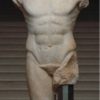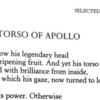3: Poem excerpt, Rainer Maria Rilke’s “Archaic Torso of Apollo,” 1918, English translation from German, and photograph of statue.
Margolin admired Rilke’s work and his influential idea of “thing-poems” (Dinggedichte). She may have had this well-known poem in mind when writing “I Once Was a Youth,” especially for its vivid focus on a fragment of a Greek statue—a “torso”—that seems to possess a dynamic, life-like quality.
Suggested Activity: Rilke’s and Margolin’s poems both contain images of statues. However, the focus is less on their value as objects of art, and more on an experience of their concrete, material qualities. Have students write short “thing-poems” about an ordinary object, something they use or touch in their daily lives, encouraging them to observe and encounter these everyday objects as “suffused” with inspiration.
Sources: Rainer Maria Rilke, Ahead of All Parting: The Selected Poetry and Prose of Rainer Maria Rilke, trans. by Stephen Mitchell (New York: Modern Library, 1995), 67.
For full poem, see: http://www.writing.upenn.edu/bernstein/syllabi/readings/Rilke-Archaic.html
Torso.png
 Download image (425.93 KB)
Download image (425.93 KB) Archaic Torso of Apollo
 Download image (22.99 KB)
Download image (22.99 KB)


